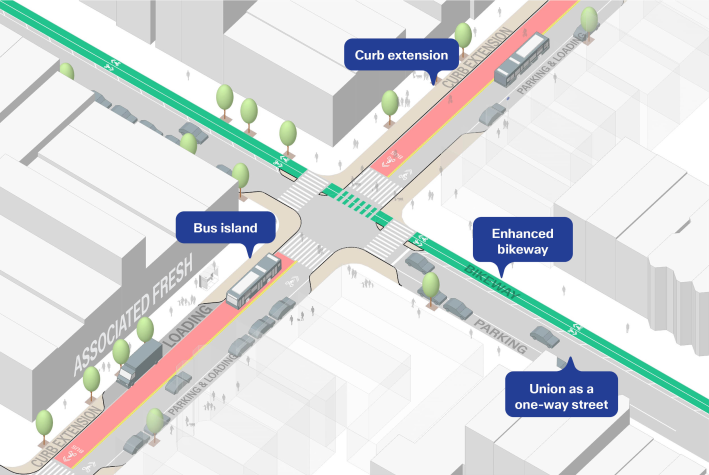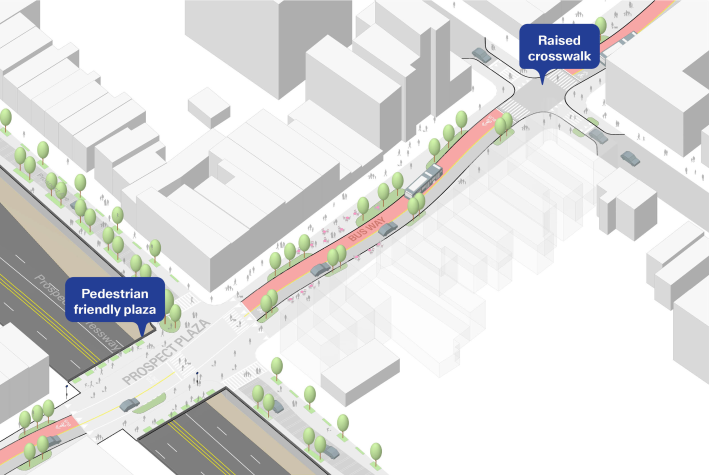Talk about paving the way.
Park Slope's small business community is working with one of the city's top architecture firms to turn sclerotic and dangerous Fifth Avenue into a complete street with wider sidewalks, safe corners, loading zones and, most important, much faster buses that could be a model for scores of shopping strips across town.
Earlier this month, the Fifth Avenue Business Improvement District, which represents 520 shop-owners between Dean and 18th streets, released the 214-page report, "Putting People First On Park Slope’s Fifth Avenue: A Vision For The Public Realm." And the emphasis of this broad, business-friendly vision is on people, the public realm and, most important, transit.
"The core takeaway from the small business community on this strip is that they want a pedestrian- and transit-priority street," said David Vega-Barachowitz, the associate principal and director of Urban Design at WXY, which surveyed the businesses and residents of the area to create the report and its recommendations. "They want to make this a great shopping street that's not double-parked all the time. It's currently a road that doesn't work for anyone, especially people on buses."
The context
The section of Fifth Avenue that runs through Park Slope and the South Slope is a business strip that could be the stuff of a glossy campaign video: mom and pop stores dominate, families congregate, cyclists stop at their favorite bar on the way home. It's a halcyon that should be accompanied by the Turtles' "Happy Together."
Or is it? The strip is also a victim of the area's growing wealth: According to Census data, the car population of the tracts on either side of Fifth Avenue grew by 15 percent between 2000 and 2023, adding hundreds of new vehicles to a relatively small area.
That, plus the explosion in the use of Ubers and apps to get food delivered, has resulted in a congested shopping strip that, as Streetsblog reported in 2018, "works for no one." (Yes, that's a triple-parked car in that picture.)
Hello @nyc_dot. Here’s today’s example of a street that works for no one. Yes, that’s a triple-parked cab. Fifth Ave at 1st St. in Brooklyn. But, sure, blame cyclists everyone. pic.twitter.com/YSMgSsdPX3
— Streetsblog New York (@StreetsblogNYC) September 15, 2018
Enter the Department of Transportation, which last year informed the business group that it intended to undertake a "street improvement project" along the length of Fifth Avenue to Bay Ridge.
"We were like, 'That's great, but what other concerns should we address?'" said Joanna Tallantire, the BID's executive director. "And we realized that pedestrian safety is crucial, but there are other issues, too, like the triple-parking, the congestion, the poor bus movement, the narrow sidewalks, the lack of loading zones, etc. And this plan addresses that."
The talk
Surveys of hundreds of residents and business owners revealed that 117,764 people live within a half-mile of Fifth Avenue — and 82 percent of commuters do not use a car. That's a large number of people seeking to access a vibrant strip without an auto.
Yet sidewalks are narrow, many intersections are unsafe to cross and cyclists are endangered because of high car volumes, double-parking and no dedicated space north of Carroll Street. More than 500 people were injured by car drivers just in the business improvement district zone from 2020 through April 2025.
And don't get us started about bus riders: The B63, which runs through the entire business improvement district, averaged 5.5 miles per peak hour on weekdays in August, which is 34-percent slower than the city-wide peak average.
In surveys, business owners said their number one concern was "vehicle traffic/congestion" and "pedestrian safety," and slow bus speeds cracked the top six concerns.
"What we heard is that a street like Fifth, as well as other neighborhood commercial corridors, can't be doing everything for everyone all the time," Vega-Barachowitz said. "The stakeholders here wanted to make it better for pedestrians and buses, which will be better for business. They understand how important that is."
The plan
Architects drew up all sorts of possible plans — a car-free roadway with a wide, two-way bike lane, a regular two-way street but with so much pedestrian space that there would be no parking, a one-way roadway with a bus lane and a two-way bike path and a "Slope Park" design that would add a protected bike lane and more space for pedestrians — but ended up with a final vision that achieves safety and better bus service by restricting cars to northbound between Ninth and Union streets and southbound from Dean to Union streets to accommodate bus lanes.
"If you want to better leverage the roadway, it means that Fifth Avenue should not be a two-way street its entire length," Vega-Barachowitz said.

The final proposal doesn't do much for cyclists — who are currently endangered on Fifth — but would beef up protections on Ninth Street and Union Street.
"There was a lot of interest in improving things for bike riders," Vega-Barachowitz said. "Bikers won't have a bike lane that's frequently double-parked, but they will be welcome and safer because there will be less car traffic."
And sidewalks will be widened in some places and parking turned into loading zones so the buses can flow more freely.

Of course, the rubber of big dreams always meets the reality of New York's slow roadway progress, so the final plans feature preliminary phases as sort of a proof-of-concept while the capital money is lobbied for, raised and, hopefully, spent.
"We know things move slowly in this city, but it's good to have aspirations to remind people what we're trying to reach," Tallantire said.
The local Council member, who is almost certainly going to be re-elected next week, is on board, which is a crucial part of the process.
"The plan shows that the community is deeply concerned about safety," said Council Member Shahana Hanif (D-Park Slope). "And that the small business community on Fifth Avenue recognizes that safer streets bring more people to shop and dine and hang out. Plus it prioritizes buses."






